EMG United Kingdom
- EMG Global
EMG Countries
- EMG Belgium
- EMG France
- EMG Germany
- EMG Italy
- EMG Netherlands
- EMG USA
EMG Brands
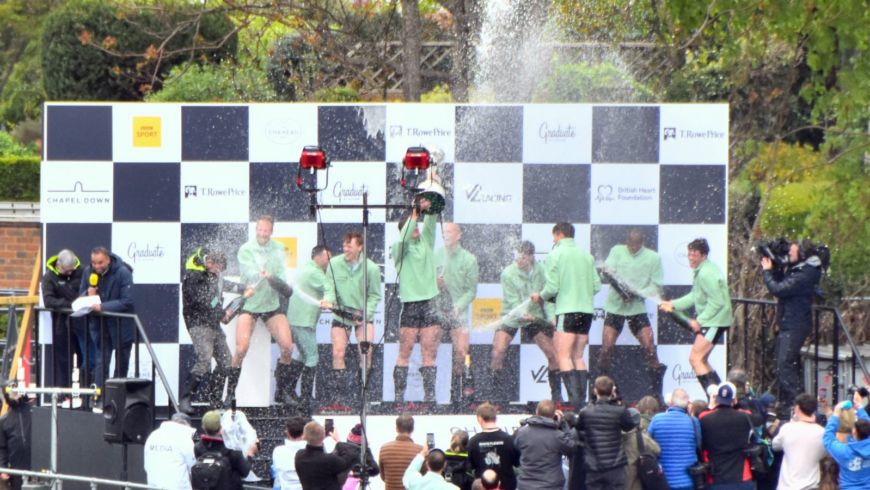
On Sunday 13th April, the 170th Boat Race was held on its traditional 4.25 mile course on the River Thames in London. Cambridge won both the men’s and women’s races in the 2025 Boat Race. With these victories, Cambridge University now has 88 wins in the men’s race and 49 in the women’s, bringing their total to 137 across both races. This highlights just how long the Boat Race has been going. Indeed, it will celebrate an astonishing 200 years in 2029, but at EMG / Gravity Media we’re currently just celebrating one: the first successful coverage of the race enabled by EMG Connectivity.
While our OBs have worked on the race for over ten years, 2025 is the first time that we have looked after the RF aspects of the event as well, making it a whole group effort. It represents some interesting challenges for RF too. Radio signals never propagate over water as well as they do over land, bridges block signals as the boats pass under them, while the end-to-end nature of the course and the fact that it winds through the built environment of London represents its own difficulties.
All in all its a huge operation with complex logistics that required almost 100 crew, 25 from EMG Connectivity alone, who had to start work days before the event to rig the antennas along the length of the course.
This year our team dealt with three separate councils for bay suspensions for parking and agreement for television work on council land; six private dwellings that were needed for camera or RF access; erected 46 scaffold points for camera positions and RF positions; utilised seven boathouses at the Putney end of the course; and then had to implement 24/7 security to make sure everything was still in place and where it should be with no surprises for the big day, 1500 hours of it in total.
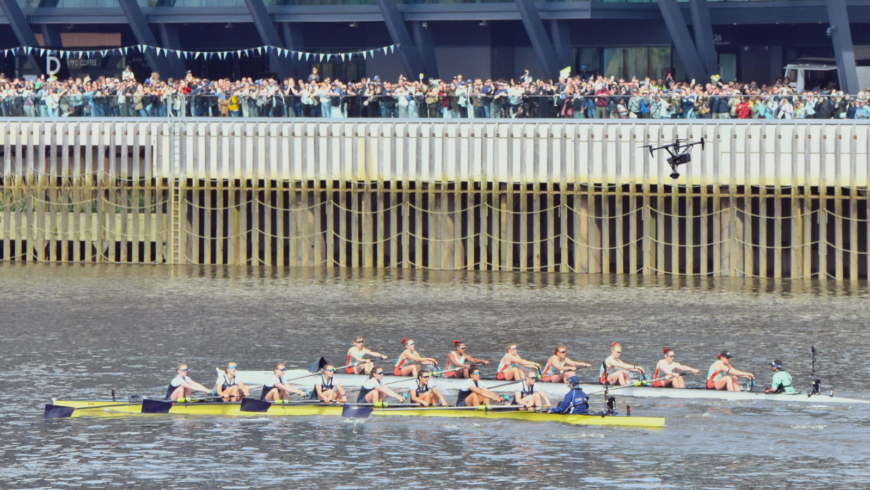
CAPTURING ALL THE ACTION
As you would expect, there were both a lot of cameras dotted along the route and plenty both on the flotilla and covering its journey along the course to Mortlake. 25 were either in fixed positions or primarily assigned to specific areas on dry land.
"We had 16 antennas at the Putney Bridge OB receive site alone, with a network of receive antennas spanning the entire course," explains Chris Brandrick, Commercial Director at EMG Connectivity. "In my 20 years working with wireless cameras, I've never encountered such a complex setup for a single RF project."
As far as roving cameras go, EMG / Gravity Media’s specialist camera division, ACS, provided helicopter coverage using an advanced gyro-stabilised GSS Cineflex camera. Aerial views were further augmented via a DJI drone camera being operated from one of the chase boats. Additional ACS GSS Cineflex cameras were mounted on one of the chase boats and Umpire’s boat, ensuring perfectly stable close-up pictures of the racing action is it unfolded even in choppy waters.
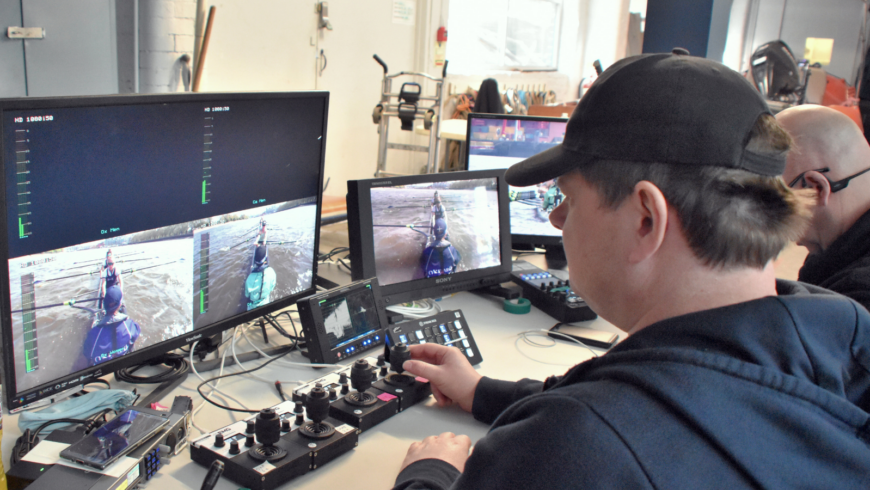
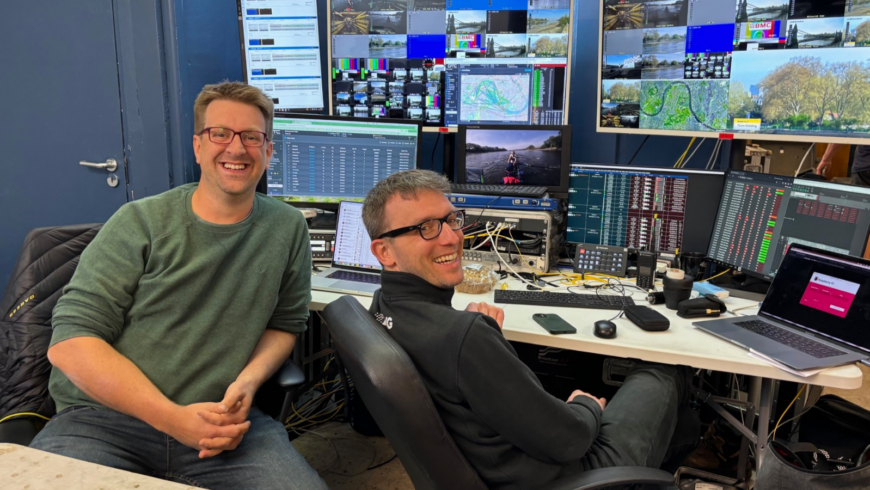
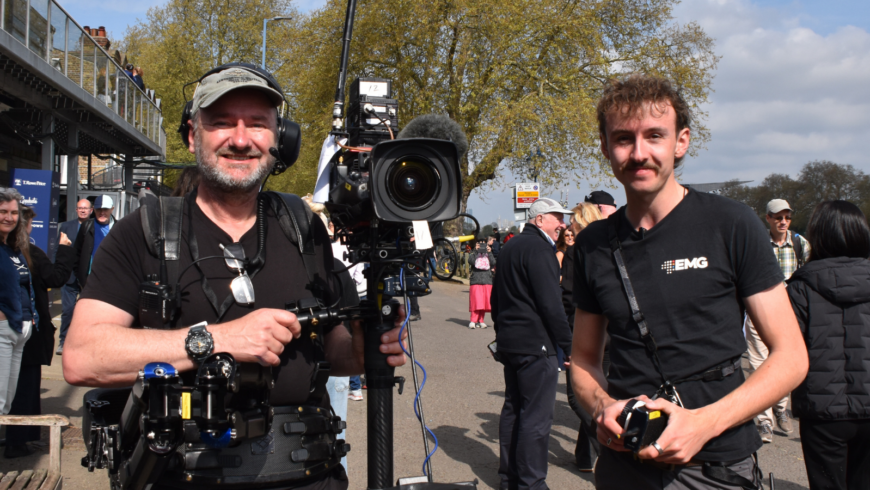
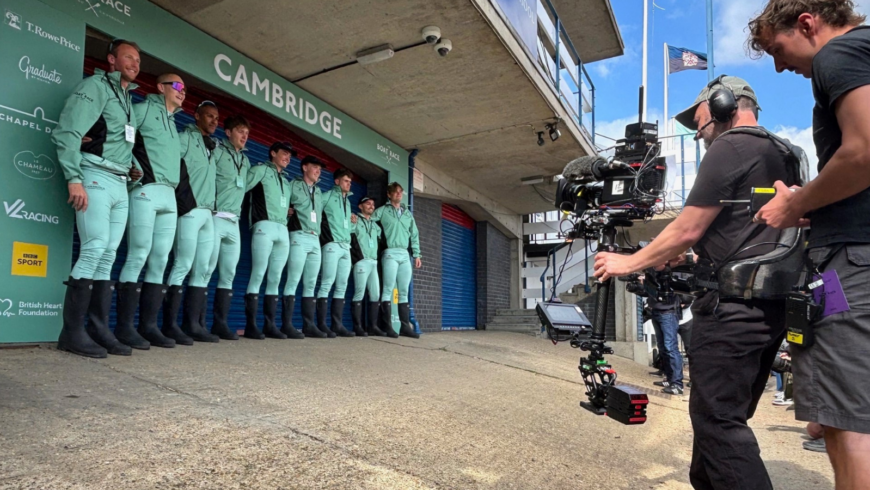
As always, some of the most iconic images came from the University boats themselves. Each boat in the Men’s and Women’s races was equipped with two Dream Chip Atom One Mini Waterproof onboard cameras, housed in custom-built frames supplied by Videosys Broadcast. One camera was fixed, capturing the cox, while the other, a high-behind pan-and-tilt camera, provided a dynamic view of the rowers. A Domo Mesh unit enabled remote camera control and data control. To ensure clear footage, a compressed air system was also onboard to clear the lens if it got wet during the race.
Two different systems were used to coordinate and communicate between all those waterborne and aerial cameras.
The video transmission from all waterborne and airborne cameras was handled by the latest iteration of EMG Connectivity’s self-developed Livetools RF system which supports HEVC compression for even greater bandwidth efficiency. This proved itself on the Seine last summer during the Opening Ceremony of the Paris 2024 Olympics where our teams worked closely with NBC to deliver its coverage to the vast audiences watching in the US.
Similar to the Opening Ceremony in Paris, the reception of the RF signals from the boats uses shore-based receive sites along the river. Five sites were used with a total of 34 reception antennas. This is all brought back to the Putney Bridge main OB via an IP network, switched and decoded for a clean output on air from each camera.

“Livetools is proprietary to EMG / Gravity Media, and this marks its debut in the Boat Race. Introducing a new technology in such a high-profile event is always a bit nerve-wracking, especially when it’s the first time,” says Brandrick. “However, Livetools has already been proven in production, and we were confident it would perform on the Thames—and it did, as the stunning images from the Race demonstrated.”
A Domo Mesh network was used to communicate between the shore sites and all cameras, providing data and comms to each position through 20 deployed Mesh nodes along the route. Domo’s IP MESH creates a private, long-range, bidirectional IP network using a single frequency, where each node can serve as a data destination or a repeater to extend network coverage. This allows large-scale productions to maximise communication, delivering talkback, camera control, and transmitter function control.
GENERATING SUSTAINABILITY
With a number of camera single power positions along the course, as well as those on board the boats, a small petrol generator has traditionally been used to power the equipment. For this year’s race, however, after significant testing the team moved away from this method and opted to use eight Ecoflow Delta 3 units, which also have a solar charging input. The benefits to the environment are clear, but they also bring added benefits including less noise, no petrol onsite, no fumes, and fewer H&S considerations for storage etc. They are also much lighter!
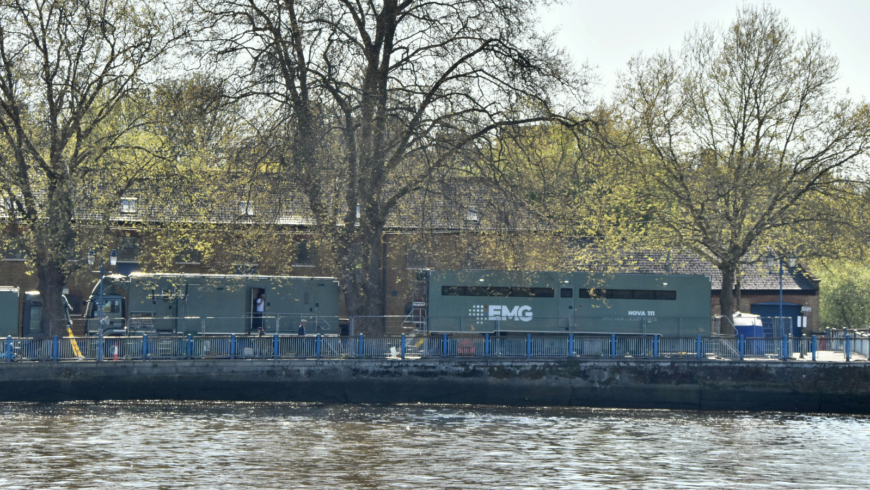
A MARATHON ENDEAVOUR
There’s little time for the EMG Connectivity team to rest and relax though. Despite it being an odd year in the sporting calendar, the events are coming thick and fast and in under two weeks the TCS London Marathon takes place.
We’ve handled the RF and OBs for the event since 2014 and are continually evolving the way we implement its RF to not only reflect new technologies and production methods but also to cope with the many challenges it presents.
“The London Marathon is probably the most difficult marathon to cover in the world, because, like the Boat Race, it meanders through a heavily congested city,” says Brandrick, pointing to the forest of tall buildings that is Canary Wharf and the multiple tunnels along the course. “We do it differently to the Boat Race, however, with multiple fixed camera sites, two helicopters, and six motorbikes on the course that are relaying up to a single relay aircraft.”
There is a definite skill in implementing this. It’s a large area to cover with the bikes often extremely spread out on the course. The team needs to position the plane perfectly to ensure that coverage of the Elite runners and wheelchair racers finishing at Buckingham Palace is maintained while the mass start is still taking place at Blackheath 11 km away.
We’re also expanding on the innovation that so many enjoyed last year where McFly’s Harry Judd could contribute to the broadcast as he ran the course. This year the plan is to involve more celebrity runners, so we will be meeting them at badge collection and installing and testing a special app on their phones. Production can then call them during the race, ask them to fire up the app, and feature them talking as they're running in the broadcast.
“The London Marathon and the Boat Race are both multi-site OBs, and they’re both sprawling events that wind through London, but in terms of RF they’re covered completely differently,” concludes Greg Livermore, EMG / Gravity Media’s Technical Producer for the Boat Race and the London Marathon. “They show the importance of tailoring RF differently to each and every event, to broadcaster’s requirements, to developments in technology, to the budget available, and to the unique characteristics of the sport and event in question.”
Do you have questions or need information? Fill in your contact details and we'll contact you as soon as possible!
"*" indicates required fields